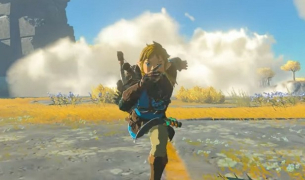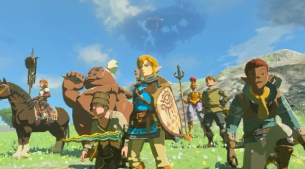The latest addition to the Zelda series, The Legend of Zelda: Tears of the Kingdom, is a game that goes beyond a mere successor to the highly regarded Breath of the Wild. It elevates the experience to such a degree that it's nothing short of a gaming epiphany. Harnessing the essence of the franchise's storied past, it synthesizes the finest elements to forge a product that strikes emotional chords, entrances players and showers them with rewards for their curiosity.
Breath of the Wild boldly took players into an expansive, exploratory adventure, harking back to the original NES installment's free-roaming spirit. Tears of the Kingdom walks a similar path, presenting a familiar yet subtly altered landscape. This changed environment bristles with fresh opportunities for discovery, ensuring that each turn and each ascent brings with it the promise of a new endeavor. Even amidst tranquility, Hyrule seems alive, teeming with energy. The musical score underscores this dynamic, with stirring renditions enhancing moments of urgency, then subsiding to allow the full absorption of the world's ambiance.
Revolutionizing Zelda: Enhanced Mechanics and Creative Freedom in Tears of the Kingdom
Contributing to the sense of the altered world are the enhanced mechanics for interaction. Echoing Breath of the Wild's initial plateau, it isn't until you acquire four pivotal skills within a foundational area that you are truly unleashed upon the open realm. These abilities form the core of Tears of the Kingdom, placing a greater emphasis on creativity than before. You are compelled to build and experiment, finding inventive solutions to various obstacles—a natural progression from Breath of the Wild's already invigorating exploratory gameplay.
The abilities named Ultrahand and Fuse stand out for their roles in revolutionizing exploration and combat. Ultrahand empowers you to combine a diverse assortment of items, ranging from simple building materials to intricate Zonai machinery. Conversely, Fuse allows the augmentation of your weaponry, enabling the attachment of various items to enhance their functionality, much like how Ultrahand operates. These abilities complement each other, spurring a continuous cycle of imaginative contraption crafting—from modifying a raft with Zonai components to altering your battle gear with strategically placed explosives.
The contemplation on weapon longevity, a hot-button issue in Breath of the Wild, is ingeniously reconceptualized. Though Fusing extends an item's lifespan, the underlying message is far more profound. Where Breath of the Wild focused on scarcity and managing finite resources, Tears of the Kingdom advocates for an abundant experimental ethos. Commonly found items become the basis for creative experimentation, reducing the preciousness typically associated with gear. This philosophy encourages a sandbox-like approach: merging, flinging, and enjoying the delightful outcomes.
Unlocking New Heights with Recall and Ascend
Complementing the central abilities are Recall and Ascend, which were gained early yet have pivotal roles. Recall lets you reverse the state of objects—useful in both battle scenarios and when solving puzzles. Ascend offers the ability to move vertically through solid surfaces, opening up new exploration possibilities from unseen chambers to lofty heights.
An additional tool, Autobuild, though not mandatory, becomes increasingly useful. Building upon the Ultrahand functionality, it enables quick assembly of pre-saved or preferred designs, streamlining the construction of vehicles and devices for any given situation.
These new mechanics alter the reliance on the stamina meter for climbing, and the verticality they introduce is complemented by Skyview Towers. These structures are not just control points on a map but also act as launch points, propelling Link skywards. Upon reaching the Sky Islands, you'll find a whole new layer of exploration awaits. Soaring into the heavens and descending back down is exhilarating. From this vantage point, you can glide towards specific objectives or simply scout for new areas to investigate.
The Zelda Experience: From Land to Sky in Tears of the Kingdom
In this new chapter of the Zelda series, every aspect from land to sky is ripe with potential, making each journey through Hyrule a limitless adventure. As I took to the skies in The Legend of Zelda: Tears of the Kingdom, I was astounded by the seamless experience, an especially impressive feat given the concerns surrounding the older Switch hardware's capabilities. Most of my playtime was in handheld mode, where only on the rarest occasions, like navigating a busy Kakariko Village amid a storm, did I witness any frame rate drops—and even then, they were subtle and fleeting. The game's more ambitious visual feats, astonishingly, seemed to run without a hitch. When docked, yes, the sharpness of distant sights while airborne was slightly reduced, yet the game's art style masterfully glossed over these shortcomings. Nintendo, with help from Monolith Soft's known prowess as exemplified in Xenoblade Chronicles 3, has again defied expectations with the Switch's hardware.
Tears of the Kingdom's map brims with Shrines dotting the landscape, offering not just puzzles for the keen mind but also serving as travel conduits alongside the Skyview Towers. These Shrines further represent growth, enhancing your vitality and endurance with each completion. I found myself activating them primarily for later travel. A novel item also allows for the extension of your portable power source, ensuring your Zonai machinery's longer operational life. And below the surface, the extensive subterranean realm beckons, where Brightbloom seeds illuminate the way, and unique bioluminescent plants offer their own quick-travel network. This tri-layered world, each stratum infused with a distinct mood, heightens the sense of embarking on a genuine exploration.
These tools, along with the expansive world they inhabit, channel a distinctive rhythm that feels fresh in the Zelda universe. Your role isn't merely to crack puzzles or vanquish foes—you're devising innovative solutions. The game encourages you to creatively bridge gaps, strategize through combat, and untangle complex enigmas. Should a strategy fall short, you're inspired to refine and reattempt. The beauty lies in the freedom of approach; creativity is rewarded, yet even basic tactics can carry you through the story, ensuring accessibility regardless of your approach.
The map's four grand regions align with the four major temples, echoing traditional Zelda dungeons over Breath of the Wild's Divine Beasts, each Temple named for an element like Wind or Fire. Although structurally akin, diverse in theme and feel—a lavish blend that pays homage to classical dungeons, inviting nostalgia, coupled with fresh, bold sequences that redefine Zelda's dungeons.
These Temples, however, don't have the expected Zelda-style key item for puzzle navigation. Instead, accompanying you within each is a lovable companion from the myriad cultures in Hyrule, offering their unique abilities for problem-solving and skirmishing in lieu of a new gadget. They inject a blend of charisma and utility, making the Temples more about wit than warfare, until you reach the formidable bosses that rigorously test all your acquired skills and allied powers. You're free to leave and return, with the game accommodating for such strategic retreats, allowing continual access to the dungeon upon your prepared return.
The game's open structure inevitably means that not all skills build upon previous ones, contrary to the linear progression of older titles where puzzle complexity could assume your possession of all earlier items. This compromise is the price of an open-world design, yet it's a fair trade-off as each Temple weaves its puzzles around your unique abilities proficiently.
These dungeons are woven into the tapestry of a riveting central narrative. The story captivates, beginning with unraveling the mystery of a blight emerging beneath Hyrule Castle, leading to an encounter with a familiarly lifeless figure tightly held by a magical arm—Ganondorf. The drama intensifies with the revival of this ancient foe, an ensuing skirmish, and Zelda's disappearance into darkness. With the seal broken and Zelda missing, Link's quest to reunite the Sages across races ensues—a mission fueled by bloodlines and ancient pacts waiting to be fulfilled. Each Sage's struggle with their duty underscores a subplot within their respective Temples, underpinning the game's overarching themes of heroism and community.
Conclusion: An Odyssey of Creative Freedom and Legendary Moments
Yet above all, Zelda's presence is central to the story, with the main narrative thread interweaving scattered clues and sightings of her throughout the kingdom. The unraveling of her whereabouts, revealed in a piecemeal fashion, eventually crescendos into a profound, unforgettable moment—a narrative apex that joins the ranks of the most legendary Zelda moments and tugs at the heartstrings with unprecedented force.
Such is the storyteller's craft in Zelda: Tears of the Kingdom, where your own gameplay stories intertwine with the grand narrative—a world where creativity is your greatest weapon, where you chart your own lore across vast terrains and skies, and where every interlude of exploration contributes to an ever-unfolding legend. This is no ordinary game, it's an odyssey that rewards as generously as you get involved in its world.









